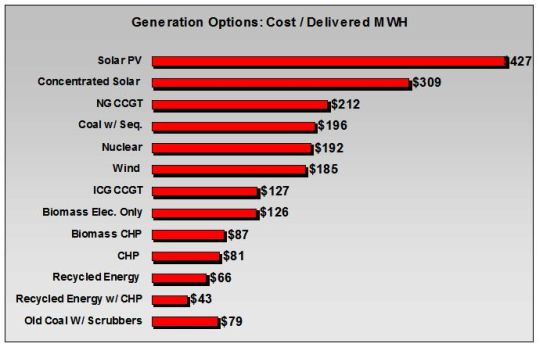The following is a guest post from Tom Casten, chairman of Recycled Energy Development LLC.
—–
Rep. Edward Markey (D-Mass.), chair of the House Subcommittee on Energy and Environment, along with Rep. Todd Platts (R-Pa.), has introduced legislation calling for 25 percent of U.S. electricity to come from clean energy by 2025. What will such legislation do to electricity costs?
Most pundits assume the current system is optimal, and thus claim that any mandate to change this “best of all possible worlds” will raise the price of delivered electricity. It is hilarious to think the protected and regulated electric system is optimal, but depressing to realize no one is laughing. Consider two questions:
- Do market forces drive electricity suppliers to lowest-delivered-cost solutions?
- What is the delivered cost of clean energy from various generation options?
What market forces? All electricity distribution systems and many generation plants enjoy monopoly protection. Subsidies abound. Profits are guaranteed. Old plants can legally emit up to 100 times the pollution of a new plant. A century of rules reward and protect yesterday’s approaches and the resulting vested interests.
Congressman Markey has never seen current generation as optimal, and now that he chairs the relevant subcommittee, he proposes to mandate cleaner and, in our view, cheaper electricity generation. Yes, we said cheaper. Anyone interested in some facts?
The chart below depicts a comprehensive analysis of the delivered cost of a megawatt-hour from old coal plants and from 12 cleaner options. The bottom bar depicts societal delivered cost from an old coal plant that has been retrofitted with pollution controls to meet 2015 EPA standards. This coal generation, the dominant form of U.S. generation, emits 1.05 to 1.25 tons of CO2 per delivered MWh. The other bars depict the cost of delivered power from 12 generation options with reduced or no CO2 emissions. The costs include capital amortization for generation, transmission and distribution and backup generation, plus fuel and operating costs and line losses, all spread over each technology’s likely operating hours per year. The costs also exclude all subsidies and thus depict full societal costs for each generation option.

Source: Internal analysis of Recycled Energy Development LLC.
The three lowest cost sources of clean energy cost less or the same as power from the dominant old coal plant generation, but these carbon-free and low-carbon options supply only 7.5 percent of U.S. generation. Instead, 56 percent of U.S. power comes from more expensive and dirtier old coal.
Every passing month sees more power industry requests to regulators and states to approve investment (i.e., guarantee returns) in integrated coal gasification plants, nuclear plants, and experimental coal plants that will attempt to sequester some of the CO2 emissions. These central generation options the power industry favors will cost the public between $127 and $212 per delivered MWh, which is three to five times the cost of power from the cheapest clean option — recycled waste energy. Sadly, some state governments are drinking this power industry Kool-Aid. Illinois just passed a law requiring distribution utilities to pay $210 per MWh (21 cents/kWh), plus delivery, for power from a new coal plant that hopes to sequester half of its CO2.
Many environmentalists lobby for a pure renewable energy portfolio standard, excluding the cheaper clean options. This mandate would effectively induce wind power, given the high cost of solar. New wind generation can deliver power at a lower cost than nuclear or coal with sequestration. What is surprising is that new wind is less expensive than delivered power from natural gas combined cycle plants. Yet the power industry has deployed 120,000 MW of new natural gas generation capacity since 1995. Capital costs for new gas turbine plants are less than half the cost of new wind capacity, but natural gas is so expensive that the plants operate less than 25 percent of the time. The capital recovery is spread over relatively few MWh. Our analysis assumed 30 percent per year load factor and still found natural gas more expensive than any technology but solar.
So much for the myth that “market forces” work in the electricity space.
Could government unleash market forces in the electricity space? Sure, but look at the changes required and then count votes:
- End all subsidies of petroleum, coal, nuclear, wind, biomass, and solar energy
- Repeal all electric distribution monopoly protection and allow anyone to install private wires
- Repeal all generation monopoly protection
- Privatize all federal power agencies, rural electric cooperatives, and rural utility service, exposing these customers to the cost of private capital
- Remove all rate making assurances of return on utility investment in generation, transmission, and distribution
- Remove all grandfathered permit status from all existing electricity and thermal generation plants and replace with output-based allowances that decline over time, forcing all generators to bear the cost of pollution
- Add carbon dioxide to the list of regulated pollutants and apply the same rules as above, thus sending price signals on the cost of pollution
What is the probability of the above changes to laws and regulations? Precisely zero!
Reps. Markey and Platts propose the next best thing, forcing the deeply protected power industry to move towards cleaner (and overall cheaper) generation options.


